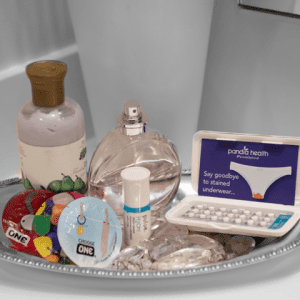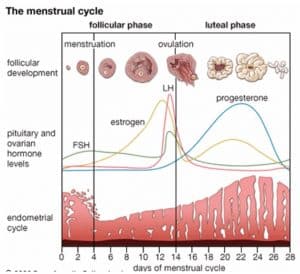Medically reviewed by Sophia Yen, MD, MPH – Written by Pandia Health Editorial Team
Birth Control & Endometriosis
The birth control pill is one of the most popular birth control methods in the United States. With typical use, it is 91% effective at preventing unwanted pregnancies. Additionally, the pill offers people with uteri an array of health benefits, including managing endometriosis. The following article explores the relationship between hormonal birth control and endometriosis.

What is endometriosis?
Approximately 10% of women in their childbearing years have endometriosis, a health condition caused by irregular endometrial tissue growth. Every month, the uterus builds up its lining to prepare for a fertilized egg. If an egg does not implant in the lining, hormone levels fall, triggering its shed (a.k.a. your period). In cases of endometriosis, some endometrial cells grow outside of the uterus in places they don’t belong. This causes inflammation and pain, and could lead to infertility and/or cancer.
Where can endometrial cells appear?
Theoretically, endometrial cells can appear anywhere in the body. That being said, the most common areas include the following:
- Ovaries – the two oval-shaped organs located on the upper right and left of the uterus that produce, store, and release eggs
- Fallopian tubes – the tubes attached to the side of the uterus that serve as a passageway for eggs released from the ovaries
- Bladder – the muscular sac in the pelvis that holds urine
- Kidneys – the bean-shaped organs located on either side of the spine that remove waste from the body in the form of urine
- Colon – the portion of the large intestine that removes water, nutrients, and electrolytes from partially digested food (to later be removed as stool)
- Intestines – the continuous tube between the stomach and anus that absorbs nutrients from food
There is no specific explanation as to why endometriosis occurs in different areas of the body for different individuals. However, it most commonly involves the ovaries, fallopian tubes, and tissue surrounding the pelvis.
What are the complications of endometriosis?
Endometriosis may lead to numerous negative consequences related to reproductive health including, but not limited to, the following:
Infertility
Individuals with endometriosis may experience difficulty getting pregnant. In some cases, they may even be infertile (a.k.a unable to have a baby). That said, having endometriosis doesn’t guarantee infertility. If conception is a challenge, in vitro fertilization (IVF) may be an alternative for some individuals.
Adhesions and ovarian cysts
Adhesions form as part of the healing process after tissue in the pelvic region sustains an injury. In individuals with endometriosis, they appear as clumps of thick scar tissue. On the other hand, ovarian cysts are fluid-filled sacs on the ovaries. While some are harmless, others may cause pelvic discomfort.
Bladder and bowel problems
When endometrial adhere to the bladder and bowels, the individual may experience painful urination, bloating, constipation, and/or diarrhea. These symptoms are often mistaken for those associated with Irritable Bowel Syndrome (IBS).
Chronic pelvic pain
Endometriosis may lead to general discomfort in the pelvic area. While some individuals may only experience soreness during sex and menstruation, others may suffer from constant pain.
Regardless of the intensity of symptoms, it is always a best practice to consult a doctor when you notice changes to your health.
What causes endometriosis?
While the exact cause of endometriosis is unknown, numerous theories have been suggested:
- Genetics – individuals are more likely to experience endometriosis if their family members have the disorder
- Retrograde menstruation – occurs when some of the womb lining flows up through the fallopian tubes and imbeds itself in the organs of the pelvis
- Immune system complications – the immune system serves as the body’s natural defense against disease; when it’s interrupted, disease is more likely to occur
- Endometrial cell movement – the cells of the endometrium may spread through the bloodstream or lymphatic system
Endometriosis may also be caused by a combination of factors. Any person with a uterus may develop the condition.
What are the symptoms of endometriosis?
Endometriosis has numerous symptoms that can greatly impact an individual’s life. While the majority of these symptoms are physical, they can have a significant emotional impact. The common symptoms of endometriosis include:
- Severe abdominal pain before and during menstruation
- Painful and/or heavy periods
- Pain during or after sex
- Discomfort with urination or bowel movements
- Lower back tension
While these symptoms are typical for many individuals, others may experience no notable changes in their bodies.
How is endometriosis diagnosed?
Endometriosis is only diagnosed via surgical laparoscopy, a procedure in which a small incision is made in the abdomen. A thin tube with a camera is inserted into the abdominal wall, which allows the doctor to examine an individual’s organs. While this method is low-risk and minimally invasive, it can be expensive. That said, a doctor may first perform additional tests to ensure that an individual’s symptoms are related to endometriosis. More specifically, they may conduct a pelvic exam and/or ultrasound to check for cysts and scarring around the uterus.
How is endometriosis treated?
While endometriosis may not go away entirely, symptoms can be improved with the help of various treatments including:
- Anti-inflammatory medications (i.e. ibuprofen)
- Hormone therapy
- Hormonal birth control
- Medications that release gonadotropin hormone (GnRH) agonists
- Surgery (i.e. hysterectomy)
Doctors typically prescribe less intense treatments to start. If these are ineffective, surgery may be recommended as a last resort.
How can birth control help treat endometriosis?
Birth control pills that contain high levels of progestin may be particularly effective at improving symptoms. Similarly, those that are monophasic (a.k.a release a steady dose of hormones each day) may be beneficial, as they typically leads to lighter periods. Regardless of which pill an individual is on, they have the option to take it continuously by skipping the last row of the pack and moving on to the next right away. This prevents endometrial cells from shedding, which in turn, reduces inflammation and irritation that results from a period.
The hormonal IUD (i.e. Liletta, Mirena, Skyla) can also be used in the treatment of endometriosis. This type of birth control is inserted directly into the uterus through the cervical canal and releases progestin. As a result, it often leads to lighter periods, thus, reducing the severity of pain.
Want to find the best birth control for endometriosis?
Sign up for Pandia Health and our expert birth control doctors will find the best treatment for you.
- FREE Online Doctor's Consult*
- Starting at $7 per pack or FREE with insurance (cancel anytime)
- FREE delivery and FREE goodies
- Expert care by expert birth control doctors
- With or without a prescription, we can help you!
*Pricing may vary.
What’s the takeaway?
Endometriosis affects many individuals with uteri. While this disorder is unpleasant, it can be treated with relatively non-invasive methods. Hormonal birth control is one method that may be implemented to reduce the severity of symptoms.
How can Pandia Health help?
Are you suffering from endometriosis? It may be time to consider taking hormonal birth control. If you already have a prescription you love, sign up for our free delivery service to get your birth control shipped right to your mailbox. No prescription? No problem! We also offer online consultations with our expert doctors for patients in select states. With Pandia Health, you can be confident that you’re in good hands when it comes to your birth control needs.
Frequently Asked Questions
What are the first signs of endometriosis?
Common signs of endometriosis include painful and/or heavy periods, pain during sex, problems with bowel movements, and infertility (i.e. inability to get pregnant).
Where does endometriosis pain occur?
Endometriosis pain typically occurs in the lower back and abdomen. It is more intense than normal period pains.
What is the treatment for endometriosis?
Endometriosis can be treated with the use of certain medications such as NSAIDs (i.e. ibuprofen) or hormonal birth control. Surgery may be recommended if symptoms do not improve with other treatments.
What is an endometrioma?
An endometrioma is a cyst formed out of endometrial tissue that resides upon the ovaries.
What is endometrial tissue?
Endometrial tissue forms on the inside of the uterus and sheds during your period. It serves as a protective wall for the womb, providing both a place for a fertilized egg to implant itself and for nutrients to support the placenta during pregnancy.
Disclaimer: The above information is for general informational purposes only and is NOT a substitute for professional medical advice. Always consult a doctor for specific questions related to your health.





